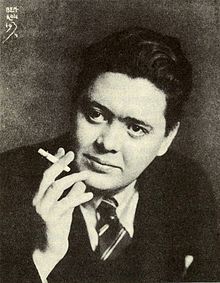|
Waldemar Hammenhög
Per Waldemar Hammenhög (18 April 1902 – 1 November 1972) was a Swedish writer and novelist.[1] The trivial, petty bourgeois urban environment forms the basis of many of his early realistic novels, whereas his later works turned towards religious and moral issues.[2] Writing more than 40 novels, Hammenhög is probably best known for Pettersson & Bendel (1931), a humorous novel adapted twice to screen.[3] Life and workBorn in Stockholm in 1902 as Waldemar Anderson,[4] he was the son of foreman Per Anderson and his wife Lydia Källgren.[4] After graduating from the Högre realläroverket å Östermalm high school in Stockholm in 1919,[4] Hammenhög worked as an office boy,[4] and later office clerk until 1930.[1] He left his job as a clerk after he was awarded first-prize in a novel competition organized by the Stockholm-based publishing house Natur & Kultur with his debut novel Esther och Albert.[1] He submitted the text under the pseudonym "Hammenhög", which became his official name in 1931.[5] Among Hammenhög's writing highlights is the humorous novel Petterson & Bendel (1931), adapted to screen in 1933 starring Adolf Jahr as Pettersson; and as P&B (1983) starring Stellan Skarsgård as Petterson and Allan Edwall as Bendel. Esther och Alberts äktenskap (1936) was also a success, adapted to screen as Ung man söker sällskap (1954), starring Ulf Palme and Gaby Stenberg.[6] In the late 1940s, Hammenhög's writing turned from realistic humor towards moral issues as he was struggling with personal alcoholism.[3] His writing reached a turning point with Torken (1951),[7] a novel about the failure of traditional alcoholic care. The novel is sometimes regarded as Hammenhög's second breakthrough as a novelist.[2] A year later, Hammenhög published Omne animal (1952), a novel which implied that Hammenhög was heading toward Roman Catholicism. Most novels that followed often focused on religious and moral issues.[2] Later life and deathHammenhög's early commercial success as a productive novelist[5] led to an extravagant lifestyle, and severe alcoholism.[3] For years, alcoholic problems influenced his writing which was largely devastated by superficiality and haste.[8] Later in life, Hammenhög became a "sober alcoholic".[3] In that capacity, he frequently spoke in public about issues related to his alcoholism.[3][8] Writing in newspapers, his signature was W H-g.[1][4] Hammenhög died in Stockholm in 1972 at the age of 70.[1] He is buried at the Roman Catholic Cemetery, a part of the Norra begravningsplatsen Cemetery in Solna Municipality north of Stockholm.[9] Bibliography
References
|
||||||||||||||
Portal di Ensiklopedia Dunia
